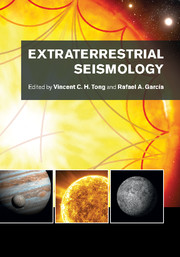Book contents
- Frontmatter
- Contents
- List of contributors
- Preface
- Acknowledgements
- List of abbreviations
- Planetary seismology: High risk, high return
- A bright outlook for helio- and asteroseismology
- Part I Observation and space missions
- Part II Data and physical parameters
- 4 Asteroseismology: From the telescope to the modeler's desk
- 5 Global helioseismology and asteroseismology of solar-type stars
- 6 Measurements with local helioseismology
- 7 Planetary seismology: Early observational results
- Part III Modeling approaches
- Part IV Discoveries of physical structures and processes
- Part V Interdisciplinary research involving planetary and astrophysical sciences
- Part VI Interdisciplinary research involving terrestrial seismology
- References
- Index
7 - Planetary seismology: Early observational results
from Part II - Data and physical parameters
Published online by Cambridge University Press: 05 July 2015
- Frontmatter
- Contents
- List of contributors
- Preface
- Acknowledgements
- List of abbreviations
- Planetary seismology: High risk, high return
- A bright outlook for helio- and asteroseismology
- Part I Observation and space missions
- Part II Data and physical parameters
- 4 Asteroseismology: From the telescope to the modeler's desk
- 5 Global helioseismology and asteroseismology of solar-type stars
- 6 Measurements with local helioseismology
- 7 Planetary seismology: Early observational results
- Part III Modeling approaches
- Part IV Discoveries of physical structures and processes
- Part V Interdisciplinary research involving planetary and astrophysical sciences
- Part VI Interdisciplinary research involving terrestrial seismology
- References
- Index
Summary
Introduction
There have only been three occasions in the past where seismic data from the surface of an extraterrestrial body were successfully acquired, although several unsuccessful attempts have been made, as discussed in Chapter 3. The first was during and following the Apollo landing missions on the Moon in 1969 through 1977, the second was during the Viking mission on Mars in 1976 through 1978, and the third was the Soviet Venera missions to Venus in 1982. During the Apollo project, three seismic experiments were conducted at various landing sites: Passive Seismic Experiment (PSE) at Apollo landing sites 11, 12, 14, 15, and 16; Active Seismic Experiment (ASE) at landing sites 14 and 16; and Lunar Seismic Profiling Experiment (LSPE) at the Apollo 17 landing site. These landing sites are indicated on Figure 7.1. During the Viking project, seismometers were deployed at two landing sites, Viking 1 and Viking 2, but the seismometer at the Viking 1 site failed to uncage, and only at the Viking 2 landing site were records of ground motion obtained. The Venera 13 and 14 measurements lasted only briefly, 127 and 57 minutes, respectively.
In this chapter, we briefly describe the Apollo and Viking experiments and summarize key findings of the contemporary analyses of the acquired data. Included are some historical accounts of events experienced at the time. Since the turn of the century, with vastly more powerful computers now available and with developments of new analysis techniques, these decades-old data are attracting renewed interest, and new results are emerging. These new results are described in Chapter 15. The results of the Venera experiment will not be discussed here because information available to the western world is scarce. We understand that only a single event of unknown origin was counted (e.g., Ksanfomaliti et al., 1982). The chapter will end with a brief account of remaining questions and suggested future directions in lunar and planetary seismology.
- Type
- Chapter
- Information
- Extraterrestrial Seismology , pp. 91 - 106Publisher: Cambridge University PressPrint publication year: 2015
- 1
- Cited by



